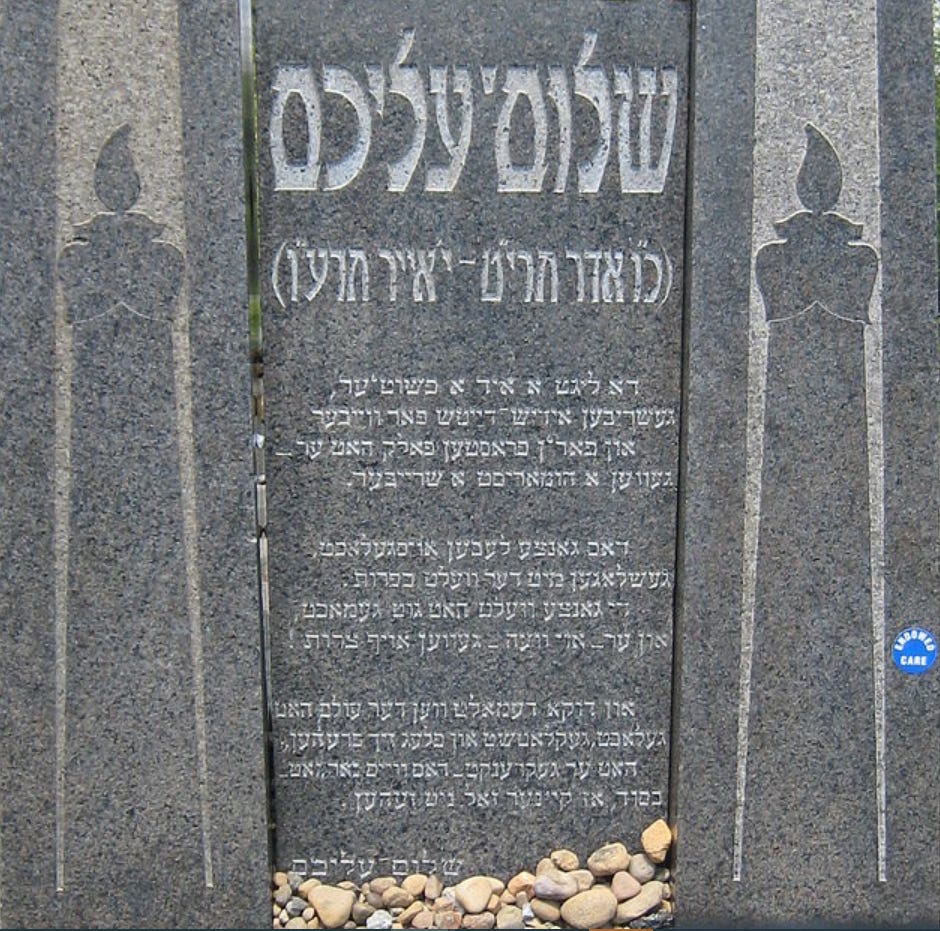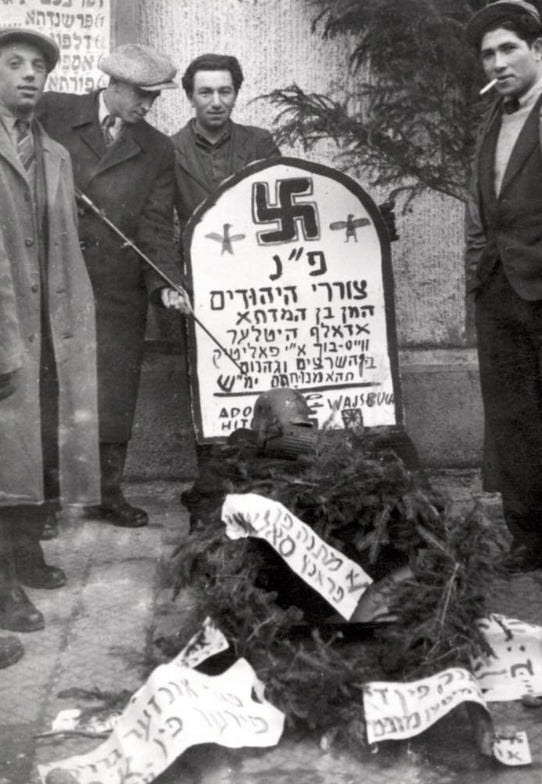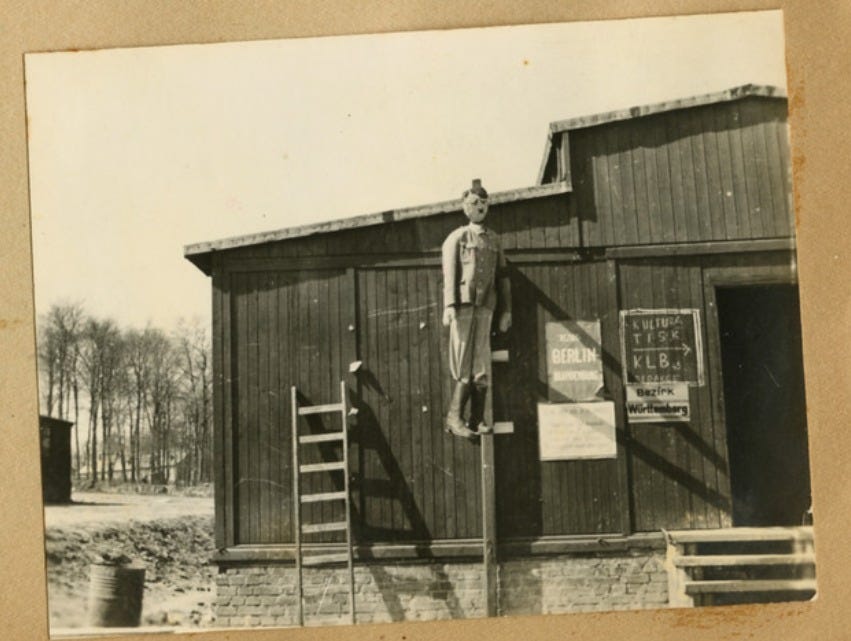The accompanying shiur is available on the Orthodox Union's parsha learning app: All Parsha.

The Jewish People finally escape Egypt. The slavery has ended but the redemption has not yet been realized.
After a change of heart, Pharoah and his army relentlessly pursue the Jewish People. The newly freed young nation is terrified as they see the formidable Egyptian army gaining on them. The Jewish People are very scared, and they scream out.
“Were there no graves in Egypt?!” the Jewish People ask Moshe, “Why have you taken us from Egypt, just to die in the desert?”
This is a strange reaction for a moment of crisis. The Jews surely knew there were plenty of graveyards in Egypt, so why in such a serious moment would they ask such a frustratingly rhetorical question? Are they trying out a new bit?
In fact, as Rav Samson Rafael Hirsch explains, that is exactly what they were doing. This is the first example of Jewish humor.
As Rav Hirsch explains, “This sharp irony, even in the moment of extreme fear and despair, characterizes the humorous streak that is ancestral to the bright tribe of Yaakov.”
It is a fascinating comment, but still makes you wonder why, according to this approach, is such a monumental moment—the redemption of the Jewish People—interrupted with something so trivial. A moment earlier, the Jewish People were terrified and cried out, and the next moment they’re cracking jokes?
And, more broadly, what role does humor play in the larger story of Jewish redemption?
To understand all of this, let’s explore some of the history of Jewish comedy.
On Easter Sunday, April 19, 1903, a pogrom erupted in Russia. What began with broken windows and looting ended in a barbaric massacre of Jews. Almost fifty Jews were killed, including babies.
The great Jewish poet, Chaim Nachman Bialik, was sent to Kishinev by the Jewish Historical Commission to document the attack. In 1904, following his visit, Bialik published his now classic poem, “In the City of Slaughter” (בעיר ההרגה). The poem was somber, even broken. As Daniel Gordis describes in his book Israel: A Concise History of a Nation Reborn:
The exile of the Jew from his own land, Bialik claims, has more than robbed the Jew of his strength and his courage. It has eroded his capacity to feel. Exile has destroyed him.
The horrors of Kishinev played an instrumental role in creating the urgency needed for the nascent Zionist movement to take off. In 1903, Herzl couched the entire Zionist movement as a reaction to the Kishinev Pogroms. “Kishinev exists wherever Jews undergo bodily or spiritual torture, wherever their self-respect is injured and their property despoiled because they are Jews. Let us save those who can still be saved!”
Not everyone reacted so somberly.
Solomon Rabinovich, better known by his pen name, Sholom Aleichem, published his first essay twenty years before the Kishinev Pogrom. In 1903 he had already developed an international reputation. The Kishinev Pogrom affected Sholom Aleichem deeply. He personally organized fundraisers for the families of the victims. As an ardent Zionist and member of Chovevei Tzion, Sholom Aleichem did not take Jewish persecution lightly. Still, his works found a way to find some semblance of humor even amidst the horrors of the Russian persecution.
In Sholom Aleichem’s short story, “An Exchange of Letters Between America and the Old Country,” written just a few years after the Kishinev Pogroms, he imagines an exchange of letters between Yisrolik in Russia and Yankel and America. The letters display the effects of the Pogrom and the characteristic Jewish resilience and humor in the face of persecution. Here is a snippet from Yisrolik’s letter describing life in Russia:
Dear Yankel: You ask me to write at length, and I’d like to oblige, but there’s really nothing to write about. The rich are still rich and the poor are dying of hunger, as they always do. What’s new about that? And as far as the pogroms are concerned, thank God we have nothing more to fear, as we’ve already had ours—two of them, in fact, and a third wouldn’t be worth while. . . . All our family got through it safely, except for Lippi, who was killed with his two sons, Noah and Mordecai; first-class artisans, all three of them. Oh yes, and except Hersh. Perel was found dead in the cellar together with the baby at her breast. But as Getzi used to say: ‘It might have been worse; don’t think of the better, because there’s no limit to that.’ You ask about Heshel. He’s been out of work now for over half a year. The fact is they won’t let him work in prison. . . . Mendel did a clever thing; he up and died. Some say of hunger, others of consumption. Personally, I think he died of both. I really don’t know what else there is to write about, except the cholera, which is going great. . . .
In 1905, after another pogrom in his hometown of Kiev, Sholom Aleichem decided to leave Russia and move to America. After moving to America, he spent a few years living in Geneva, Switzerland, but eventually moved back to the States in 1914. He died two years later at the age of 57.
Most people today know Sholom Aleichem from the Broadway musical Fiddler on the Roof that was based on his short story, Tevye and his Daughters. Fiddler on the Roof debuted on Broadway in 1964—almost fifty years after his death. Still, when Sholom Aleichem passed, he was an internationally renowned writer and humorist. Famously, when Mark Twain heard that Sholom Aleichem was called the “Jewish Mark Twain,” he responded, “Please tell him that I am the American Sholem Aleichem.”
His funeral attracted over a hundred thousand mourners. As the New York Times reported, police were worried that there would be a repeat of some of the riots that broke out upon the death of New York’s Chief Rabbi, Rabbi Jacob Joseph when he passed in 1902. A few hundred children followed the procession reciting psalms. The crowds were not just mourning a Jewish writer, but someone who captured the comedic absurdity of the shtetl life—persecution, tradition, and Jewish resilience.
Sholom Aleichem wrote the Yiddish epitaph on his tombstone himself. He reminds his readers that for all the humor he shared, he quietly still held a great deal of suffering.
Here lies a plain man
Who wrote in plain Yiddish
And to readers he was known
A humorist, a writer
He laughed all through his life
He fought the whole world
But all the world was the gainer
And he only the loser.
And while the world was merry
And saw in him but gladness,
Poor man, he suffered on the quiet
God knows, but no one else did.
Sholom Aleichem set up a charitable fund for struggling Jewish writers. He did not want any monuments erected in his memory, much like the words of the Talmud Yerushalmi, אין עושין נפשות לצדיקים דבריהם הן הן זכרונן (We do not erect monuments for the righteous, their words are their legacy).
I was on this German talk show and the host asked me, “Why do you think there is not so much German comedy?”
“Well, did you ever think you killed all the funny people?”
—Robin Williams
A few decades after the passing of Sholom Aleichem, the bounds of Jewish comedic resilience would be tested again in ways previously unimaginable. The horrors of the Holocaust, many thought, would mark the end of Jewish humor in the face of tragedy. It was simply too much.
As Irving Kristol wrote in Commentary in 1951, “Jewish humor died with its humorists when the Nazis killed off the Jews of Eastern Europe, though it seems likely that even without the intervention of Hitler this humor would not long have survived the disintegration of the ghetto community from which it drew its inspiration.”
He was wrong.
Already in 1947, Moyshe Nudelman published, Gelekhter durkh trern, Laughter through Tears, about comedy in postwar Poland. The title itself was a nod to Sholom Aleichem whose writing was popularly described as allowing the Jewish People to laugh through their tears.
Emanuel Ringelblum, who led the Oyneg Shabbos operation that documented the conditions of the Warsaw Ghetto records several jokes Jews would say about their horrid conditions. “We eat as if it were Yom Kippur, we sleep in Sukkahs, and dress as if it were Purim,” goes one joke recorded by the legendary archivist of the ghetto. Another line has a teacher asking a student, “What would you like to be if you were Hitler’s son?” The student replies, “An orphan.”
Following the Holocaust, Jews channeled much of their despair into creative, oftentimes comedic endeavors. As Avinoam Patt explains in his powerful article, “Laughter through Tears: Jewish Humor in the Aftermath of the Holocaust”:
Jewish humor in the DP camps was a means of regaining a sense of normalcy after the war. As was the case during the war, it also served as a coping mechanism to deal with suffering and trauma and to counter absurdities of the postwar situation. Jewish DPs were acutely aware of the intense irony of their continued existence in postwar Germany. In various ways, they noted this irony, whether in a casual photo of Jewish youths sitting in front of the Wannsee train station, or in the appropriation of Nazi estates for kibbutz work—some 40 farms were created for this purpose, administered by young Zionists. One of the estates had belonged to Julius Streicher (publisher of the infamous Der Stürmer), who was awaiting trial in nearby Nuremberg. The estate was renamed Kibbutz Nili, an acronym for the biblical phrase “netzahࣱ yisrael lo yeshaker” (the Eternal One of Israel will not prove false). According to one of the kibbutz leaders: “This is one of the greatest Jewish satisfactions . . .to be able to see Hebrew writings and slogans like “Am Jsroel chaj” (the People of Israel live), [and] “Necach Jsroel loj jeszaker” at Streicher’s palace; thus we have named our new kibbutz, the first agricultural school in Bavaria.” When showing around an American visitor, one of the kibbutz members pointed out two dogs, named Julius and Streicher, explaining: “They obey and protect us! It’s a pity to humiliate innocent animals with such swinish names. But we couldn’t resist the temptation.”
Purim took on a special significance in the DP camps. As my friend Yehuda Fogel once shared on social media, in a DP camp in Landsberg, Germany, survivors made a mock grave for Haman and Hitler on Purim. In Buchenwald, following the war, an effigy of Hitler could be seen hanging outside of the barracks.
As Patt concludes his article, such humor served an important purpose—reminding the world and themselves that Jewish life will continue. As he writes:
After the war, humor was a poignant affrmation of mir zaynen do—we are (still) here—a declaration that the Jewish People had not disappeared and indeed could at times have the last laugh. Jokes and other sayings told by Jews in ghettos and camps manifested the many functions of humor identified by survivors in Ostrower’s study: the aggression and anger of the oppressed, the self-humor that was typical of Jewish life, the dark gallows humor of those who felt death was imminent, and the humor of last resort, which expressed the absurdity of life under such impossible circumstances. In addition, as Israel Kaplan demonstrated, humor had a critically important social function during and after the war: namely, maintaining social cohesion under extreme circumstances while also embracing the wit and resourcefulness of the oppressed and celebrating it in the aftermath of the war. Postwar humor, in the form of humorous songs, theater, jokes, literature, and art, functioned on various levels that adapted to the realities of Jewish life in liberated Germany: as a means of processing the recent trauma of the war; asserting Jewish endurance in the wake of the destruction; enduring the implausible situation of continued Jewish existence in postwar Germany; confronting the hypocrisy of British policy; and uniting Jews in their “laughter through tears,” by this means providing them with assurance that life would continue, even after the greatest trauma the Jewish People had ever endured.
There are several theories that try to explain what makes something funny. Some have emphasized humor’s ability to affirm our superiority. Laughter, in this school, always comes at someone else’s expense—and that expense purchases a momentary feeling of supremacy. Others—most famously Freud in his 1905 work Jokes and Their Relation to the Unconscious—emphasize comedy’s ability to provide a sense of relief for our pent-up emotions. Freud writes:
If there is a situation in which, according to our usual habits, we should be tempted to release a distressing effect and if motives then operate upon us which suppress that affect in statu nascendi [in the process of being born] … The pleasure of humor … comes about … at the cost of a release of affect that does not occur: it arises from an economy in the expenditure of affect.
This theory certainly has merit, but it leads to some uncomfortable and questionable conclusions about what makes us laugh. For example, does anyone who laughs at a joke in poor taste have repressed feelings of aggression or bias?
The theory that has always resonated with me is known as The Incongruity Theory of humor. Simply stated, this theory explains that humor arises when a normal sequence is abruptly broken. For instance, a well-dressed man is not expected to slip on a banana peel. The larger the incongruity the more potential for humor. The philosopher Schopenhauer explains it this way:
Many human actions can only be performed by the help of reason and deliberation, and yet there are some which are better performed without its assistance. This very incongruity of sensuous and abstract knowledge, on account of which the latter always merely approximates to the former, as mosaic approximates to painting, is the cause of a very remarkable phenomenon which, like reason itself, is peculiar to human nature, and of which the explanations that have ever anew been attempted, as insufficient: I mean laughter… . The cause of laughter in every case is simply the sudden perception of the incongruity between a concept and the real objects which have been thought through it in some relation, and laughter itself is just the expression of this incongruity (1818/1844 [1907], Book I, sec. 13).
The setup for a joke establishes a sequential line of thinking—the punchline introduces the incongruity.
The reason I have always found this theory so satisfying is because I think it speaks to one of the primary tools human beings use to cope with the incongruities of life. Whether the jokes are about our mothers, celebrity worship, airport tuna fish sandwiches, or parenting, comedy is commentary on the chaos of life. A satisfying life that unfolds sequentially is hardly grist for comedic material. Life’s frustrations, disappointments, and perceived meaninglessness is what makes the comedic lens so valuable.
James K. Feibleman, a little-known philosopher, wrote an obscure article in The Journal of Philosophy (35:16, 1938) where he explains what comedy seeks:
Comedy then, criticizes the finite for not being infinite. It witnesses the limitations of actuality, just as a tragedy witnesses the fragmentary exemplifications of the logical order. Tragedy affirms continuity by showing how it exists in every actual thing and event. Tragedy shows the worth of every actual, down to the most ephemeral, and so is always close to the permanent value of the worshipful. Comedy comes to the same affirmation, but inversely and by indirection, just as one might affirm beauty by criticizing the ugly. Comedy catches the principle of unity in every finite thing…
Great comedians are commentators. They highlight a finite world in disarray and through comedy, a lens of meaning is superimposed onto our quotidian lives. Comedy seeks a life with meaning and when situations and circumstances seem bereft of sense, comedy provides one.
In perhaps the grandest sense, the meaningfulness that comedy seeks lies at the heart of our human experience. It is how we ultimately seek to construct our respective sense of self. Life is filled with all sorts of moments and routines that seem short of true import. Comedy is one way in which we criticize the finite moments of our existence and “catches the principle of unity in every finite thing.”
And this is why humor features so prominently in the moment of the Jewish People’s redemption from Egypt. They transform their cries (ויצעקו) into comedic quips (צחוק). The suffocating finitude of their predicament is transformed into transcendence. Even as the Egyptian pursuit bears down on them, the Jewish People retain their redemptive power to joke.
Humor is a mysterious power. It can transform even the darkest tragedies and find a glimmer of optimism. However dark the setup, the punchline creates transcendence.
Shabbos Reads — Books/Articles Mentioned
No Joke: Making Jewish Humor, Ruth Wisse
Is Jewish Humor Dead? Irving Kristol
Jewish Comedy: A Serious History, Jeremy Dauber
Does God Have a Sense of Humor, Daniel Feldman
Sholem Aleichem and Others: Laughing Off the Trauma of History, David G. Roskies
“Laughter through Tears”: Jewish Humor in the Aftermath of the Holocaust, Avinoam Patt
The Jewish Sholom Aleichem, Joseph Epstein
Check out All Parsha, where you can find weekly audio of Reading Jewish History in the Parsha, as well as other incredible presenters and amazing features that will enhance your Parsha journey!
Reading Jewish History in the Parsha has been generously sponsored by my dearest friends Janet and Lior Hod and family with immense gratitude to Hashem.








